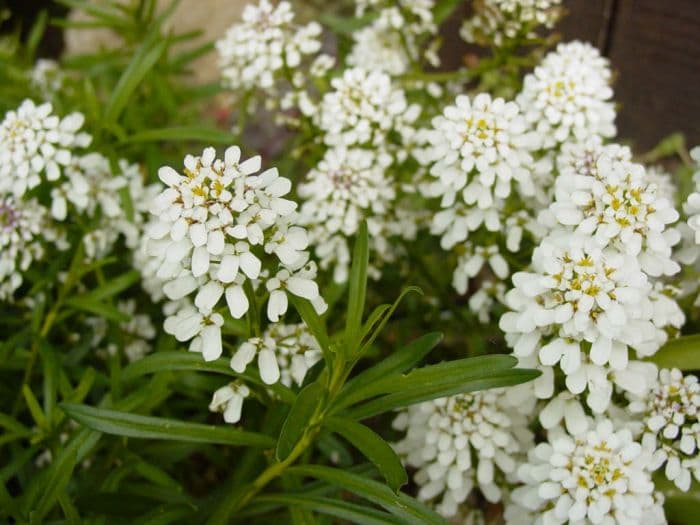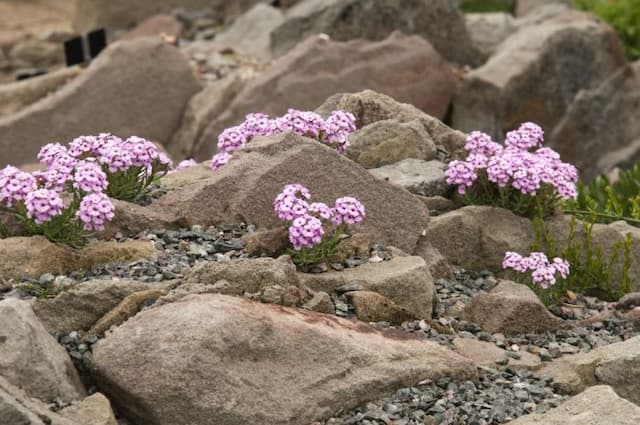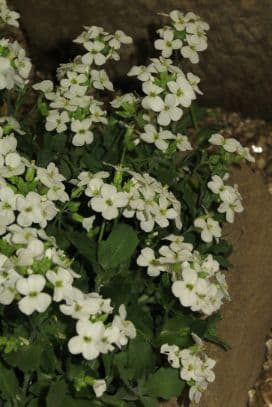Candytuft Iberis sempervirens 'Snowflake'

ABOUT
The Iberis sempervirens 'Snowflake', commonly known as Candytuft 'Snowflake', is an evergreen perennial that exhibits a low, mound-like growth habit. This plant is well appreciated for its abundant blossoms, which are pure white in color and cluster tightly together to create a striking effect when in full bloom. The individual flowers are small but numerous, contributing to a dense mat of floral cover that resembles a blanket of snow resting atop the foliage. Candytuft 'Snowflake' has deep green, glossy leaves that are narrow with a slightly oblong shape, and they are arranged in a dense, compact manner along the stems. This gives the plant a lush, rich texture even when it's not flowering. When it is in bloom, the abundance of white flowers juxtaposes beautifully with the dark green foliage, creating an eye-catching contrast. The foliage often persists year-round, offering a consistent backdrop for gardens even when the plant isn't blooming. Overall, Candytuft 'Snowflake' makes an attractive ground cover or border plant, and its striking appearance makes it a favorite among gardeners for adding splashes of bright white to landscapes. Its resilience and evergreen nature ensure that it provides interest and structure to garden settings throughout the entire year.
About this plant
 Names
NamesFamily
Brassicaceae
Synonyms
Evergreen Candytuft, Perennial Candytuft, Snowflake Candytuft
Common names
Iberis sempervirens.
 Toxicity
ToxicityTo humans
Candytuft is not commonly known to be toxic to humans. There are no well-documented cases of poisoning from ingesting candytuft, and it typically does not cause harm when touched or ingested in small quantities. As with any plant, individual allergic reactions are possible, so it's always a good idea to exercise caution and avoid ingesting plants that are not generally recognized as safe for consumption.
To pets
Candytuft is generally considered non-toxic to pets, and there have been no widespread reports of serious illness connected with its ingestion by animals. While it is not known to be poisonous, if a pet were to consume a large amount of the plant, it might experience mild gastrointestinal upset due to the ingestion of non-food items, as with any plant matter. Always monitor pets around plants, and contact a veterinarian if you observe unusual symptoms or behaviors after ingestion.
 Characteristics
CharacteristicsLife cycle
Perennials
Foliage type
Evergreen
Color of leaves
Green
Flower color
White
Height
6-12 inches (15-30 cm)
Spread
12-18 inches (30-45 cm)
Plant type
Shrub
Hardiness zones
3-8
Native area
Europe
Benefits
 General Benefits
General Benefits- Low Maintenance: Candytuft 'Snowflake' is easy to care for and requires minimal upkeep once established.
- Drought Tolerant: It is capable of surviving periods of low water availability.
- Evergreen: The plant retains its foliage year-round, providing constant greenery.
- Ground Cover: Its spreading habit makes it suitable for covering bare spots and suppressing weeds.
- Attracts Pollinators: The flowers attract bees and butterflies, supporting local ecosystems.
- Deer Resistant: Generally resistant to browsing by deer, making it suitable for gardens in areas with wildlife.
- Spring Bloomer: Offers early flowers in the spring, adding color to the garden when few other plants are blooming.
- Edging Plant: Its compact nature works well for borders and edges in garden designs.
- Colorful Blooms: Produces abundant white flowers that provide visual interest and contrast in garden beds and landscapes.
- Rock Gardens: Ideal for use in rock gardens due to its tolerance for poor, well-draining soils and preference for sunny locations.
 Medical Properties
Medical PropertiesThis plant is not used for medical purposes.
 Air-purifying Qualities
Air-purifying QualitiesThis plant is not specifically known for air purifying qualities.
 Other Uses
Other Uses- Photography Sets: Iberis sempervirens 'Snowflake' can be used as a delicate, white blossoming prop in garden photography or macro photography, adding an aesthetic appeal with its dense clusters of white flowers.
- Literary Inspiration: The plant's pure white blooms can serve as a symbol in poetry and literature, representing themes of purity, new beginnings or stark beauty.
- Eco-friendly Confetti: Dried petals of the Candytuft can be used as a biodegradable confetti alternative for celebrations, reducing the environmental impact compared to synthetic confetti.
- Artistic Patterns: Artists can use the distinctive shape of the foliage and flowers of Candytuft to create natural patterns and designs in botanical prints and nature-inspired artwork.
- Miniature Gardens: Due to its compact growth, Candytuft can be used creatively in fairy gardens or miniature landscapes for intricate and detailed greenery.
- Fabric Dye: The flowers and leaves can be explored as a natural dye for fabrics, potentially yielding delicate colors and contributing to sustainable fashion practices.
- Plant Sculpting: Candytuft, with its mounding habit, can be sculpted into rounded shapes or used in knot gardens to create geometric patterns with its evergreen foliage.
- Seasonal Decoration: The fresh or dried branches of Candytuft can be incorporated into wreaths and holiday decor, especially during spring celebrations for their pristine white appearance.
- Ice Cubes: Petals of Candytuft can be frozen into ice cubes to create an elegant and edible addition to beverages for special events or garden parties.
- Theme Gardens: Candytuft can be included as a key element in white-themed gardens, where all plants flower in shades of white, creating a serene and monochromatic landscape design.
Interesting Facts
 Feng Shui
Feng ShuiThe Candytuft is not used in Feng Shui practice.
 Zodiac Sign Compitability
Zodiac Sign CompitabilityThe Candytuft is not used in astrology practice.
 Plant Symbolism
Plant Symbolism- Purity: The 'Snowflake' part of Iberis sempervirens 'Snowflake' suggests purity, as snow is often a symbol of cleanliness and unblemished beauty.
- Innocence: The white flowers of this plant can also represent innocence, again owing to the association with the color white being unspoiled and untouched.
- Everlasting Love: As an evergreen plant, Iberis sempervirens can symbolize eternal or enduring affection and relationships.
- Consistency: The plant’s ability to remain green throughout the year can represent steadfastness and reliability in symbolism.
- Protection: Evergreens are also often seen as protective symbols because they endure the harshest of seasonal changes, offering shelter and continuity.
 Water
WaterThe candytuft, or Iberis sempervirens 'Snowflake', should be watered thoroughly when the top inch of soil feels dry to the touch, which may vary depending on climate conditions but generally falls within once a week. During active growth in the spring and summer, watering may need to be more frequent, especially in hotter, drier regions. When watering, aim to provide enough water to moisten the soil deeply, using approximately 1 gallon per plant, ensuring moisture reaches the root zone. In the winter, reduce watering frequency as the plant's growth slows down and the temperature drops, being careful not to overwater and risk root rot. Always avoid letting the plant sit in soggy soil, ensuring that the pot or ground has proper drainage.
 Light
LightCandytuft thrives best in full sun where it can receive at least 6 to 8 hours of direct sunlight each day. It is well-suited for a southern or western exposure garden spot with bright, unfiltered light. However, in extremely hot climates, it may benefit from light afternoon shade to prevent scorching.
 Temperature
TemperatureThe candytuft can tolerate a wide range of temperatures but thrives in conditions between 50°F and 75°F. It can survive minimum temperatures down to about 0°F, making it suitable for many temperate climates, although prolonged exposure to temperatures below freezing can damage the plant. During the hot summer months, it can endure temperatures up to around 90°F as long as there's adequate soil moisture.
 Pruning
PruningPruning candytuft is essential for maintaining a compact, bushy shape and encouraging vibrant blooms. Prune right after the plant has finished flowering in late spring or early summer to remove faded flower heads and shape the plant. Deadheading, if done regularly, can occasionally stimulate a second, lighter flush of flowers. No pruning is necessary or recommended during the winter months.
 Cleaning
CleaningAs needed
 Soil
SoilCandytuft (Iberis sempervirens 'Snowflake') thrives in well-draining soil mixed with organic matter such as compost or peat moss. A soil pH of 6.0 to 7.5 is ideal for this plant. A mixture of two parts garden soil, one part coarse sand, and one part compost or peat will create an optimal growing environment.
 Repotting
RepottingCandytuft is not commonly repotted as it is a perennial ground cover. It is usually planted in the garden where it can spread without frequent repotting. Repotting is typically only necessary if the plant outgrows its container, which may be every few years.
 Humidity & Misting
Humidity & MistingCandytuft prefers a moderately dry climate and will flourish in typical outdoor humidity levels. It does not require high humidity and can tolerate the lower humidity found in most home landscapes.
 Suitable locations
Suitable locationsIndoor
Provide good light and well-draining soil for indoor Candytuft.
Outdoor
Place in sun, well-drained soil, water moderately, hardy plant.
Hardiness zone
3-9 USDA
 Life cycle
Life cycleIberis sempervirens 'Snowflake', commonly known as Candytuft 'Snowflake', begins its life as a seed, which upon germination in late winter to early spring, develops into a small seedling. These seedlings mature into a low-growing, evergreen perennial, forming a dense, bushy mound of dark green leaves. By late spring to early summer, the plant produces clusters of pure white flowers that attract pollinators and are pivotal for the plant's reproductive stage. After pollination, the flowers develop into fruit that contains the seeds for the next generation. Throughout the summer, the plant continues to grow and may require pruning to maintain its shape and encourage more vigorous growth for the following season. As temperatures drop in autumn, growth slows down, and the plant enters dormancy during winter, conserving energy for the next cycle of growth in spring.
 Propogation
PropogationPropogation time
Spring-early summer
The most popular method of propagating Iberis sempervirens 'Snowflake', commonly known as the Candytuft, is by softwood cuttings. This is typically done in late spring or early summer when the plant's new growth is just hardening off. To do this, select healthy, non-flowering shoots and cut a 3 to 5-inch (approximately 7.5 to 12.5 cm) segment. The cuttings should then be stripped of the lower leaves, dipped in rooting hormone, and inserted into a well-drained potting mix. It is necessary to keep them in a humid environment with indirect light until roots develop, which usually takes a few weeks. Once rooted, the cuttings can be potted up individually and grown on until they are ready to be transplanted into the garden.




![Aubrieta [Axcent Light Blue]](/_next/image?url=https%3A%2F%2Fplants-admin.emdemapps.com%2Fimages%2Fplants%2F%2Fimages%2F604b5e7128866.png&w=640&q=75)




